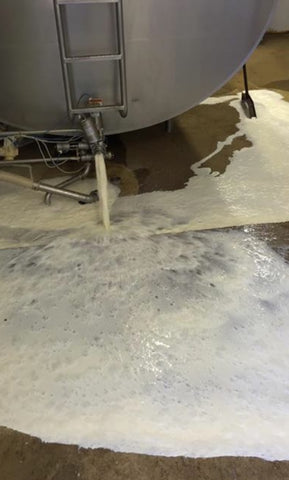On Facebook, a dairyman named Parker Hardy posted a somewhat common image that a few people may understand.

A bulk tank next to a dairy parlor was being drained of it's contents, on purpose. One of the cows being milked that day was on antibiotics for an infection and her milk should have been diverted away from the bulk tank, it was not. The antibiotics in her system will transfer into her milk and consequently into the bulk tank contaminating the entire tank. If they shipped this to the processing facility it would have contaminated an entire tanker of milk with antibiotics rendering the entire load worthless and unfit for consumption. Instead, the dairyman simply emptied that milking onto the floor costing him $1,700. A much cheaper penalty than buying the entire tanker load of milk if it had been transferred into the truck and later tested by the processing facility. The facility would have found the traces of antibiotics and then linked the traces to the bulk tank sample taken from his tank prior to filling the tanker.
Student question: I'm not going into the dairy business, who cares whether he dumped it or took a risk of being caught loading the milk into the truck?
This is one of the many health and sanitation standards that farmers and other food producers must follow based on regulations created by the Food and Drug Administration (FDA) and the U.S. Department of Agriculture (USDA). The U.S. can largely guarantee the safety of our food due to these many regulations being developed over the last several decades. The penalty for being caught knowingly defying this regulation would be: (1) The offending dairyman must purchase the whole tanker of milk from the processing plant to allow the plant to pay the other dairymen who followed the rules for the milk they produced but now can't be sold due to contamination. (2) Risk a fine from the state and federal government for the action. (3) Possible banishment from the processing facility. The dairymen would have to find someone else to buy his milk, but likely would have to explain why he was banished from his current processor. The dairymen could very quickly be out of the dairy business if he makes a poor decision.
Student question: Won't antibiotics be diluted? No one could tell one cow's milk from an entire tanker load can they?
Trace amounts of antibiotics are capable of being detected. Minuscule amounts are ignored due to leftover residue in a parlor line but there's enough antibiotics in one milking of a cow to be detected by the processor's testing procedures. The processor also tests for bleach and other cleaners that someone times accidentally get washed into the tank as well. The processor has to keep a high standard of quality in their milk so that people will want to buy it.
Teacher question: How does this apply to my class?
Animal Science - You can certainly use this in your unit in Dairy Science and dairy parlor operations. Understanding the procedures used to safely and efficiently milk cows multiple times daily. Also, diseases and disorders and how they impact the health of a cow and the milk and meat they supply.
Food Science - This picture and article can be a great lead in to the importance of our health and food safety regulations in the U.S.
Class Activity: Mock County Health Inspector
If possible, arrange ahead of time with your school nutrition director to lead your class on a tour of the food service area of the school cafeteria. An added bonus would be a blank copy of your local food service safety inspection sheet that many counties in the U.S. complete on food service areas monthly. The students can group up and "inspect" the kitchen. If the Nutrition Director isn't comfortable with that, then the alternative of just touring the cafeteria will be good as well. The Director can discuss the many food safety procedures that must be followed and why: hair nets, thermometers on cooling units, color coded cutting boards, high temperature wash stations, gloves, sneeze guards, and others. Questions to ask: how much time is spent daily in food safety practices? Are there specific standards that school cafeterias follow or are they the same as local restaurants? Do food service staff require continuing education or a certain level of certification before handling food?
Please ask questions or let us know how you used this idea for your class. I would really like your perspective. Come find us on Facebook, Pinterest, and Twitter and now Snapchat (oltaged). You can also contact me at brian@onelessthing.net.
Remember, We sell stuff too! Come see us at www.OneLessThing.net

